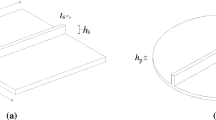Abstract
This paper deals with elastic buckling analysis of stiffened and un-stiffened corrugated plates via a mesh-free Galerkin method based on the first-order shear deformation theory (FSDT). The corrugated plates are approximated by orthotropic plates of uniform thickness that have different elastic properties along the two perpendicular directions of the plates. The key to the approximation is that the equivalaent elastic properties of the orthotropic plates are derived by applying constant curvature conditions to the corrugated sheet. The stiffened corrugated plates are analyzed as stiffened orthotropic plates. The stiffeners are modelled as beams. The stiffness matrix of the stiffened corrugated plate is obtained by superimposing the strain energy of the equivalent orthotropic plate and the beams after implementing the displacement compatibility conditions between the plate and the beams. The mesh free characteristic of the proposed method guarantee that the stiffeners can be placed anywhere on the plate, and that remeshing is avoided when the stiffener positions change. A few selected examples are studied to demonstrate the accuracy and convergence of the proposed method. The results obtained for these examples, when possible, are compared with the ANSYS solutions or other available solutions in literature. Good agreement is evident for all cases. Some new results for both trapezoidally and sinusoidally corrugated plates are then reported.
Similar content being viewed by others
References
Seydel EB (1931) Schubknickversuche mit Wellblechtafeln, Jahrbuch d. Deutsch. Versuchsanstallt für Luftfahrt, E.V. München und Berlin, pp. 233–235
Easley JT and McFarland DE (1969) Buckling of light-gage corrugated metal shear diaphragms. J Struct Div Proc of the ASCE 95:1497–1516
Nilson AH and Ammar AR (1974) Finite element analysis of metal deck shear diaphragms. J Struct Div-ASCE 100 (NST4):711–726
Easley JT (1975) Buckling formulas for corrugated metal shear diaphragms. J Struct Div-ASCE 101(7):1403–1417
Davies JM (1976) Calculation of steel diaphragm behavior. J Struct Div 102: 1411–1430
Lau JH (1981) Stiffness of corrugated plate. J Eng Mech Div-ASCE 107(1):271–275
Briassoulis D (1986) Equivalent orthotropic properties of corrugated sheets. Comput Struct 23(2):129–138
Shimansky RA and Lele M.M. (1995) Transverse stiffness of a sinusoidally corrugated plate. Mech Struct Mach 23(3):439–451
Luo R and Edlund B.(1996) Shear capacity of plate girders with trapezoidally corrugated webs. Thin-Wall Struct 26(1):19–44
Samanta A and Mukhopadhyay M (1999) Finite element static and dynamic analyses of folded plates. Engi Struct 21:277–287
Semenyuk NP and Neskhodovskaya NA. (2002) On design models in stability problems for corrugated cylindrical shells. Int Appl Mech 38(10):1245–1252
Machimdamrong C, Watanabe E and Utsunomiya T (2004) Shear buckling of corrugated plates with edges elastically restrained against rotation. Int J Struct Stab Dyna 4(1):89–104
Lucy LB. (1977) A numerical approach to the testing of the fission hypothesis. Astronomical Journal 82:1013–1024
Belytschko T, Lu YY and Gu L (1994) Element-free Galerkin methods. International J Numer Meth Eng 37:229–256
Ren J. and Liew KM. (2002) Mesh-free method revisited: two new approaches for the treatment of essential boundary conditions. Int J Comput Eng Sci 3(2):219–233
Liu GR, and Gu YT. (2000) Coupling of element free Galerkin and hybrid boundary element methods using modified variational formulation. Computa Mech 26:166–173
Gu YT, and Liu GR. (2000) A boundary point interpolation method for stress analysis of solids. Computa Mech 28:47–54
Wang J, Liew K, Tan MJ and Rajendran, S. (2002) Analysis of rectangular laminated composite plates via FSDT meshless method. Inte J Mech Sci 44:1275–1293
Liew KM, Lim HK, Tan MJ and He XQ (2002) Analysis of laminated composite beams and plates with piezoelectric patches using the element-free Galerkin method. Computa Mech 29(6):486–497
Reddy JN (1999) Theory and Analysis of Elastic Plates. Taylor & Francis, London.
Reddy JN (1999) Analysis of functionally graded plates. Inter J Numer Meth Eng 47:663–684
Shell63, Element Reference, ANSYS 6.1 Documentation
Shell181, Element Reference, ANSYS 6.1 Documentation
Beam188, Element Reference, ANSYS 6.1 Documentation.
Author information
Authors and Affiliations
Corresponding author
Rights and permissions
About this article
Cite this article
Liew, K.M., Peng, L.X. & Kitipornchai, S. Buckling analysis of corrugated plates using a mesh-free Galerkin method based on the first-order shear deformation theory. Comput Mech 38, 61–75 (2006). https://doi.org/10.1007/s00466-005-0721-2
Received:
Accepted:
Published:
Issue Date:
DOI: https://doi.org/10.1007/s00466-005-0721-2




